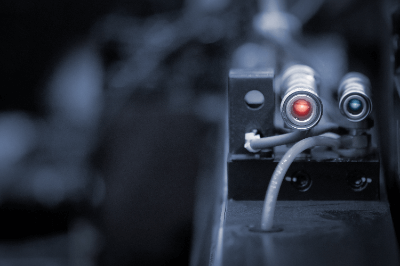What Is a Photoelectric Switch?
 A Photoelectric Switch is a device that uses light to detect the presence or absence of an object or its surface shape. Although sometimes called photoelectric sensors, photoelectric switches are especially used for contact output products.
A Photoelectric Switch is a device that uses light to detect the presence or absence of an object or its surface shape. Although sometimes called photoelectric sensors, photoelectric switches are especially used for contact output products.
The majority of light used is in the visible range or infrared light. They are characterized by long detection distances and few restrictions on the substances to be detected.
Uses of Photoelectric Switches
Photoelectric Switches are used in industrial applications. Because they can control electrical signals according to the intensity of light, they are used in a wide variety of fields, such as sensors and fiber-optic communications.
They can detect a wide range of substances, including liquids and metals, and are used to provide a contact output for their presence or absence.
They can also detect substances with low reflectance and detect differences in color.
The following are examples of applications for photoelectric switches:
- Detection of bottles and cans in beverage factories
- Edge detection of printed circuit boards
- Detection of the presence or absence of pills, such as medicine
- Detection of postcards at post offices
- Detection of workpieces in processing plants
Principle of Photoelectric Switches
Photoelectric Switches are available in a variety of detection methods, such as light transmission, retro-reflection, and diffuse-reflection types.
1. Transmission Type
In the transmission type, the light from the projector is always detected by the receiver, and the light is interrupted when an object crosses the detector. The sensor detects a decrease in the amount of light received when the light is interrupted, and the receiver outputs a contact. The features of this type of sensor are the separation of the light emitting and light receiving parts and the long detection distance.
2. Retro-Reflective Type
The retro-reflective type is a photoelectric switch in which the light emitter and receiver are combined into a single unit. The light from the projector is reflected by the reflector, detected by the light-receiving part in the projector unit, and output at the contact point. This switch is characterized by the fact that it does not require optical axis alignment.
3. Diffuse-Reflective Type
Unlike the retro-reflective type, the diffuse-reflective type has no reflector. The light emitted from the projector is reflected by the material and detected by the light-receiving part. The advantage of this type is that it has only one unit and does not require a reflector.
Types of Photoelectric Switches
There are the following types of photoelectric switches:
1. Transparent Type
The projector and receiver are combined into a separate component. They are installed opposite each other, separated only by the distance required for detection.
When installing, it is necessary to adjust the optical axis so that the projection axis of the transmitter and the receiver axis of the receiver are perfectly aligned. The maximum installation distance for the transmissive type varies depending on the product, so the specifications must be checked.
2. Groove Type/U-Shaped Type
A light emitting source and a light receiving element are housed in a case with their optical axes aligned. The light path inside the groove in the case serves as the detection range.
3. Integrated Type
This is a product in which the light emitter and receiver are integrated into a single unit. As described in the Principle section, there are two types: retro-reflective and diffuse-reflective. The retro-reflective type requires a reflector, while the diffuse-reflective type does not.
However, the diffuse reflection type can be used only when the object to be detected reflects light. It can be used for metal plates, etc., but is not suitable for detecting round or small objects. The retro-reflection type is also superior in detection accuracy.
4. Optical Fiber Type
This product uses an optical fiber for the detection part. Since it can detect any location where an optical fiber can be inserted, it can be installed in a narrow space. Since signals are transmitted and received via optical fiber, this type is suitable for use in environments that require waterproofing and explosion-proofing.
How to Select a Photoelectric Switch
It is important to select the appropriate type of photoelectric switch according to the purpose of use and environmental conditions.
Transmissive photoelectric switches, in which the light source and the light-receiving element are separated, can detect the presence of an object within a certain distance, making them suitable for object detection in factories, warehouses, and the like.
On the other hand, fiber-optic photoelectric switches are useful when waterproof and explosion-proof properties are required.
The performance of photoelectric switches is also important. It is important to compare signal accuracy, speed, and durability, and select the best switch for your purpose. In addition, the method of supplying power and wiring must also be considered in the selection process.
In addition to product selection, proper handling and maintenance are also important for long-term use.